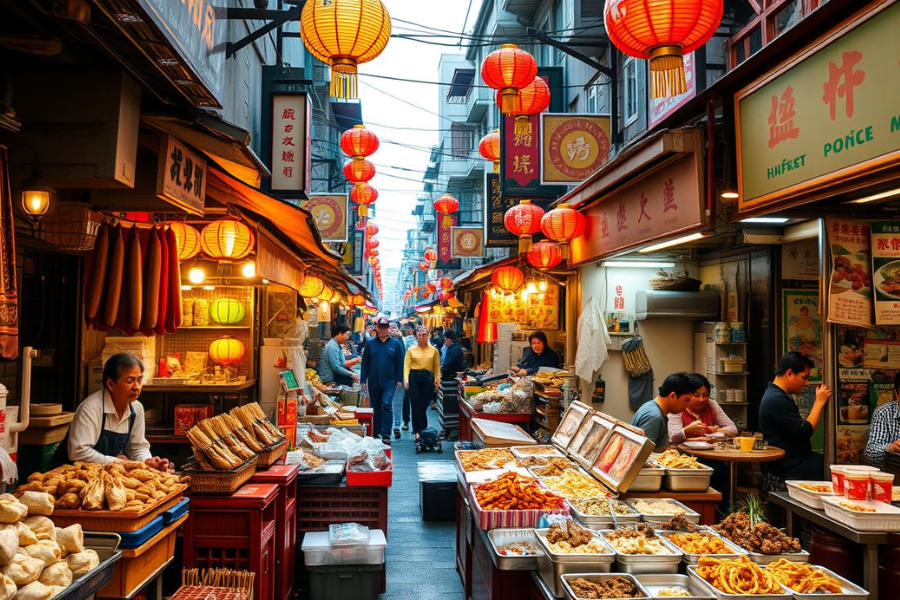Sustainability Through Chinatown Hawker Leftovers Consumption
Understanding Chinatown Hawker Leftovers Consumption
Chinatown is a vibrant hub filled with rich cultural heritage, and its bustling hawker centers are a major attraction for both locals and tourists. The air is always filled with the tantalizing aromas of delicious foods, but alongside this culinary experience, a lesser-discussed issue persists—food waste. Despite the abundance of flavorful dishes, many perfectly edible leftovers end up discarded each day. Enter the concept of Hawker Leftovers London, a movement that promotes sustainability and demonstrates the culinary innovation that Singapore’s hawker culture has to offer.
In this article, we will explore how adopting a practice of consuming leftovers can lead to significant changes in the way we handle food waste. Beneath the surface of these vibrant food stalls, there are a variety of sustainable practices at play, from the hawkers’ own eco-conscious methods to individual efforts promoting mindful eating. Let’s dive into this flavorful and sustainable world and uncover the possibilities that lie beyond the plate!
The Challenge of Food Waste at Hawker Centers
Food waste is a pressing issue at hawker centers, where the hustle and bustle often result in excess food. Vendors prepare extra portions to ensure they do not run out, but inevitably, some of this food remains uneaten, leading to large quantities of untouched meals and ingredients that go to waste.
By the end of the day, many hawker stalls throw away perfectly good food, which is a heartbreaking sight. The waste of tasty meals is unfortunate, but the real issue lies in the larger scale of wasted resources.
This practice contributes significantly to environmental damage. As food rots, it produces methane, a harmful greenhouse gas that accelerates climate change. To address this growing issue, both vendors and customers must take responsibility for reducing food waste.
Promoting awareness of leftover food consumption can potentially transform hawker centers into leaders in sustainability, balancing waste reduction with maintaining the high culinary standards that define these food hubs.
Innovative Sustainability Practices at Chinatown Hawker Centers
Hawker centers in Chinatown are increasingly adopting creative strategies and technologies to reduce food waste. A major step in this effort is the reduction of single-use plastics, with more vendors switching to biodegradable alternatives.
Additionally, many stalls are now encouraging customers to adopt a “take what you need” mindset. This promotes smaller portion sizes, reducing unnecessary waste while allowing patrons to enjoy food in a more sustainable manner.
Education plays a key role, and hawker center operators are actively conducting workshops on sustainable consumption. These workshops are well-received by both locals and tourists, increasing awareness about the environmental benefits of mindful food choices.
Many vendors also collaborate with local charities to donate unsold food, helping to support those in need while also addressing food insecurity.
These initiatives represent a growing commitment to sustainability within Chinatown’s culinary culture, providing a ripple effect that inspires other communities to follow suit.
The Advantages of Consuming Leftovers
Eating leftovers from Chinatown’s hawker stalls offers numerous benefits. For one, throwing away perfectly good food contributes to global waste problems. Instead of letting meals go to waste, consuming leftovers reduces the environmental burden.
From a financial perspective, purchasing leftover food is often more affordable than fresh meals, offering both locals and visitors the opportunity to enjoy authentic dishes at lower prices.
Leftovers also provide a convenient solution for busy individuals. When life gets hectic, having pre-cooked meals ready to eat ensures you don’t have to spend time cooking from scratch.
Supporting the practice of eating leftovers also benefits small businesses. By consuming food that would otherwise be discarded, you help hawkers continue their trade and preserve Chinatown’s culinary legacy.
Finally, eating leftovers encourages creativity in the kitchen. Mixing ingredients from different meals or repurposing dishes into new combinations allows for culinary experimentation.
Guidelines for Safe and Responsible Leftover Consumption
When enjoying leftovers from Chinatown’s hawker stalls, safety should always come first. Before consuming, inspect the food for any signs of spoilage such as off smells or unusual textures.
Proper storage is essential for preserving the quality of perishable foods. Keep leftovers in airtight containers to prevent contamination and spoilage. Refrigerate food promptly after your meal—ideally within two hours.
When reheating leftovers, ensure they reach a temperature of at least 75°C (165°F) to eliminate harmful bacteria.
For those who can’t finish an entire meal, consider portioning it out. This prevents waste and ensures that leftovers are stored in manageable quantities.
If any leftover food appears unsafe or unappetizing, it’s better to discard it than risk foodborne illness. Always prioritize safety while enjoying your meals.
Government Support for Sustainable Practices
Government action plays a critical role in fostering sustainability at Chinatown’s hawker centers. A variety of initiatives aim to reduce food waste and promote responsible consumption.
One of the most prominent efforts is the launch of educational campaigns for both food suppliers and customers. These campaigns offer tips on how to minimize waste and make the most of food scraps.
In addition, there are financial subsidies for hawker centers to support the transition from single-use plastics to more sustainable packaging options. These programs encourage vendors to adopt eco-friendly practices without straining their budgets.
Collaboration with local NGOs further strengthens these efforts. By partnering with government bodies, these organizations help fund workshops and provide valuable sustainability training for hawker vendors.
These combined efforts help not only preserve the environment but also promote a culture of responsible food consumption within the community.
Reflecting on Chinatown Hawker Leftovers Consumption
Chinatown’s hawker centers are bustling with energy, food, and a wealth of untapped potential in the form of leftovers. These unsung treasures are a valuable resource that many people are starting to embrace.
Locals appreciate the deep, rich flavors of leftover dishes, which can often taste even better with age. For example, food enthusiasts often relish the last remnants of laksa or leftover char kway teow.
This growing appreciation for leftovers is contributing to a more sustainable food culture, where people not only enjoy delicious meals but also take pride in reducing waste. Shared meals, whether enjoyed at the stall or at home, are helping to foster stronger connections between people and the environment.
In Chinatown, many vendors now offer takeaway options, allowing customers to enjoy their favorite hawker dishes later, further promoting sustainability and minimizing food waste.
Best Practices for Enjoying Chinatown Hawker Leftovers
For those who want to integrate Chinatown hawker leftovers into their meals, following these best practices can help ensure both safety and sustainability.
Start by assessing the quality of the leftovers. Use your senses to check for any signs of spoilage, such as unusual odors or textures, before eating.
When ordering, consider opting for smaller portions to help reduce the chances of leftover waste. This approach allows you to savor your food without over-purchasing.
Properly store leftover food by placing it in airtight containers to keep it fresh for a longer period. This will also help prevent contamination.
When reheating, ensure the food is heated to a temperature of at least 75°C (165°F) to ensure it is safe for consumption.
Finally, consider sharing your leftovers with friends or family. Not only does this reduce waste, but it also strengthens the sense of community around food in Chinatown.
Adopting Sustainable Practices in Daily Life
Sustainability starts with small, mindful changes. Simple actions such as planning meals ahead of time can greatly reduce food waste and make better use of local produce.
Another step toward a greener lifestyle is to support local markets and small businesses, which reduces your carbon footprint and helps sustain the local economy.
Switching to reusable bags and bottles instead of relying on disposable plastic can significantly cut down on waste.
Engaging in community activities like clean-up events is a great way to make a positive impact on the environment while meeting like-minded individuals.
Promoting a green lifestyle can inspire others to take similar actions, helping create a ripple effect that extends throughout the community.
Key Facts about Chinatown Hawker Leftovers Consumption
- Cultural Significance of Hawker Centers: Chinatown hawker centers are iconic spots in Singapore, offering an array of traditional dishes. These centers attract both locals and tourists, and the food served is deeply rooted in local culture.
- Food Waste Issue: A significant amount of food is wasted daily at hawker centers, with many dishes and ingredients going uneaten. This waste occurs due to vendors cooking extra food to ensure they do not run out during peak hours.
- Sustainability Movement: The concept of Chinatown Hawker Leftovers Consumption is gaining traction as part of a broader movement to reduce food waste, encourage sustainable practices, and raise awareness about responsible consumption.
- Educational Workshops: Many hawker centers have adopted educational programs and workshops to teach both consumers and vendors about the importance of reducing food waste, using biodegradable materials, and supporting sustainable consumption habits.
- Collaborations with Charities: Some vendors donate their unsold food to local charities, contributing to the fight against food insecurity while reducing waste.
- Economic Benefits of Leftovers: Leftover food from hawker centers is often priced lower than freshly prepared dishes, making it an affordable option for both locals and visitors. Consuming leftovers not only reduces waste but also supports the local economy.
- Health and Safety Practices: Consumers are encouraged to practice safety when consuming leftovers, including ensuring food is properly stored, reheated to safe temperatures, and checked for signs of spoilage.
- Environmental Impact: Food waste at hawker centers contributes to environmental issues, such as greenhouse gas emissions from rotting food. Reducing waste helps minimize these harmful effects.
- Government Support: Local governments are actively supporting sustainability efforts in hawker centers through campaigns, financial subsidies, and collaborations with NGOs to promote eco-friendly practices.
- Community Engagement: The practice of consuming leftovers fosters a sense of community as it encourages people to share meals, reduce waste, and build stronger social connections within the Chinatown area.
Conclusion
Consuming leftovers from Chinatown’s hawker centers offers a practical solution to food waste and sustainability challenges. This practice allows individuals to enjoy delicious food at lower prices while also reducing their environmental impact.
By embracing sustainable practices, both vendors and consumers contribute to a greener future, helping to protect the environment and support local communities. The growing awareness of the benefits of leftover food consumption is transforming Chinatown into a model of sustainability.
As more people adopt mindful eating habits and become more conscious of their food choices, this cultural shift will continue to grow, reducing food waste and promoting healthier, more sustainable diets. Through government initiatives, education, and collective action, we can look forward to a future where consuming leftovers is a common and accepted practice.
These changes will ultimately lead to long-term improvements in how we approach food waste, creating a world where sustainability is woven into the fabric of everyday life, from the hawker centers of Chinatown to households everywhere.
Frequently Asked Questions
1. What is Chinatown Hawker Leftovers Consumption? Chinatown Hawker Leftovers Consumption refers to the practice of consuming leftover food from hawker centers in Chinatown, Singapore. It aims to reduce food waste, promote sustainability, and provide affordable food options to consumers.
2. Why is food waste a problem in Chinatown hawker centers? Food waste is a common problem because hawker vendors often prepare more food than needed to meet demand, leading to leftover meals and ingredients that are discarded at the end of the day.
3. How does consuming leftovers help the environment? Consuming leftovers helps reduce the amount of food that ends up in landfills, which contributes to greenhouse gas emissions. By reusing food, we decrease waste and lessen the environmental impact associated with food disposal.
4. Are there any benefits to buying leftover food from Chinatown hawker stalls? Yes, there are several benefits:
- Leftover food is often sold at a lower price, making it more affordable.
- It reduces food waste, helping both the environment and the local community.
- Leftovers provide convenience for people who are busy and need ready-made meals.
- It supports small businesses and helps preserve Chinatown’s culinary heritage.
5. How can hawker centers promote sustainability? Hawker centers can promote sustainability by using biodegradable packaging, encouraging customers to order smaller portions, educating patrons about responsible consumption, and donating unsold food to charities.
6. What are the safety precautions when consuming leftovers? When consuming leftovers, it’s important to:
- Ensure food has been stored properly in airtight containers.
- Refrigerate leftovers promptly (within two hours of cooking).
- Reheat food to at least 75°C (165°F) to kill any harmful bacteria.
- Check for signs of spoilage (unusual smells or textures) before consuming.
7. Are government initiatives helping to reduce food waste in hawker centers? Yes, the government is supporting sustainability efforts in hawker centers by funding initiatives that promote responsible consumption, providing financial incentives for eco-friendly packaging, and partnering with NGOs to conduct sustainability workshops.
8. How can I get involved in reducing food waste at hawker centers? You can get involved by:
- Ordering only what you can finish to minimize waste.
- Choosing leftover food options when available.
- Supporting vendors who practice sustainable and eco-friendly methods.
- Participating in educational workshops about sustainability.
9. Can consuming leftovers help small businesses in Chinatown? Yes, by consuming leftovers, you help small hawker businesses reduce waste and increase their profitability. This practice ensures that food is used efficiently, supporting the continued success of local vendors.
10. How does Chinatown Hawker Leftovers Consumption contribute to a sense of community? This practice fosters community by encouraging people to share meals, appreciate the value of food, and participate in sustainability efforts together. It also builds connections between locals, tourists, and vendors through shared values of reducing waste and supporting sustainable practices.
Stay updated with the latest news and trends here at My Reading Manga!



